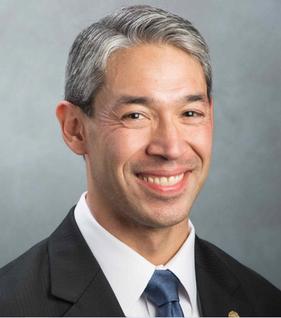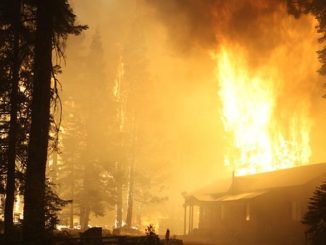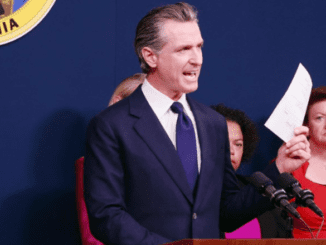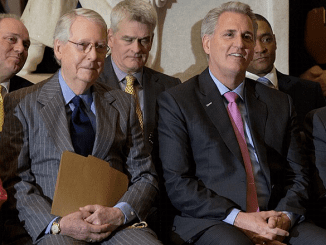
WASHINGTON, DC, July 27, 2023 (ENS) – “The existential threat of climate change,” as President Joe Biden called it, was the most urgent issue for the President at the White House and the mayors of two heat-stricken cities Phoenix, Arizona and San Antonio, Texas in their own offices, as they held a video call today. The long-lasting July heatwave that has sent temperatures into the triple digits in both cities appears to have convinced more people that climate change is a real threat.
“It is a threat,” repeated the president. “We’re going to outline steps we’re taking to help communities who, right this minute, as both the mayors can tell you, are facing a real crisis in their cities.”
“I don’t think anybody can deny the impact of climate change anymore,” Biden said. “There used to be a time when I first got here a lot of people said, “Oh, it’s not a problem.” Now, “I don’t know anybody who honestly believes climate change is not a serious problem,” he said.
Giving examples, President Biden mentioned “the historic floods in Vermont and California earlier this year,” and “droughts and hurricanes that are growing more frequent and intense. He spoke of wildfires “spreading a smoky haze for thousands of miles, worsening air quality.”
“Record temperatures are now affecting more than 100 million Americans,” Biden said. “Puerto Rico reached a 125-degree heat index last month. San Antonio hit an all-time heat index high of 117 last month. Phoenix has been over 110 degrees for 27 straight days.”
The President then turned to the eastern tropical Pacific warm water pattern known as El Niño that is happening this year, recognizing that “the short-term warming of the ocean exacerbates the effects of climate change, making forecasts even hotter in the coming months.”
“Ocean temperatures near Miami are like stepping in a hot tub,” Biden said. “They just topped 100 degrees – 100 degrees – and they’re hitting record highs around the world.”
Heat Claims 600 American Lives a Year
“The number one weather-related killer is heat,” Biden said. “Six hundred people die annually from its effects, more than from floods, hurricanes, and tornadoes in America combined. And even those places that are used to extreme heat have never seen it as hot as it is now for as long as it’s been.
“Even those who deny that we’re in the midst of a climate crisis can’t deny the impact that extreme heat is having on Americans. Americans like an elderly woman in Phoenix who fell out of her wheelchair and, after five minutes on the ground, had third-degree burns.” Third-degree burns destroy skin, nerves bones, muscles, and tendons, according to Stanford Health Care.
Heat is not only deadly and uncomfortable, it’s expensive. “Experts say extreme heat is already costing America $100 billion a year,” Biden revealed.
“And it hits our most vulnerable the hardest: seniors, people experiencing homelessness who have nowhere to turn, disadvantaged communities that are least able to recover from climate disasters.
And it’s threatening farms, fisheries, forests that so many families depend on to make a living,” Biden empathized.
Climate Resilience: a Set of Interlocking Issues
“None of this is inevitable,” Biden said, pointing to the “unprecedented action to combat the climate crisis” that he and his administration has taken.
He explained that the administration is using a law he got passed early in his term, the American Rescue Plan, to help states and cities promote energy efficiency, reduce flooding, and open cooling centers. The $1.9 trillion American Rescue Plan became law March 12, 2021.
“We’re delivering over $20 billion from the Bipartisan Infrastructure Law to upgrade the electric grid to withstand stronger storms and heatwaves so we don’t cause more fires.” Biden said at the White House today.
He reminded reporters, “Look, last year I signed the Inflation Reduction Act, the most significant climate investment ever anywhere in the world. Meanwhile, FEMA has been on the ground responding to those unprecedented weather emergencies in real time. And I’ve traveled an awful lot in that helicopter with you all across the country to see the devastation that occurs, wildfires and drought and the like.”
Help for Heat-Stricken Workers
The President became emotional as he described for reporters the suffering of workers who must work on and on, even in extreme heat.
“Like firefighters who already have to lug over 45 pounds of gear through smoke and flame, which is incredibly hot. The job is even harder and more dangerous to do in record heat,” Biden said.
He feels empathy for “farmworkers who have to harvest crops in the dead of night to avoid the high temperatures,” and “farmers who risk losing everything they’ve planted for the year.”
“Or the construction workers who literally risk their lives working all day in blazing heat and, in some places, don’t even have the right to take a water break. That’s outrageous. That is outrageous – anybody who does that,” Biden fumed.
Last year, Biden’s Department of Labor created the first national program to protect workers from heat stress. Since then, agency staff have conducted 2,600 heat-related inspections at workplaces nationwide to protect the health and safety of the workers on the job.
And today, the White House offered more help from across multiple agencies to help states and cities deal with the consequences of extreme heat.
- – The Labor Department was first. The President asked Acting Labor Secretary Julie Su to issue a Heat Hazard Alert to clarify that workers do indeed have federal heat-related protections. He asked Su to intensify enforcement, increasing inspections in high-risk industries like construction and agriculture.
- The Labor Department is already developing new workforce and workplace heat-safety rules to cope with the new heat levels.
- – The U.S. Forest Service will award more than $1 billion in grants to help cities and towns plant trees that in the long term will help repel the heat. The trees will also expand access to green spaces so families have a place to go to cool off.
- – The Department of Housing and Urban Development is providing billions to communities to make buildings more efficient and to make more heat – make them more heat-resistant, opening cooling centers in – for residential areas and in the cities that the communities can go to to be safe.
- – The Department of the Interior is using infrastructure funding to expand water storage capacity in the Western states to deal with the impacts of future droughts that have made this extreme heat more consequential.
- – The National Oceanic and Atmospheric Administration is launching a new partnership with universities and impact communities to improve the nation’s weather forecasts and its accuracy so Americans everywhere can be better prepared when they – when – and they can better predict what the heat is going to be in that community with the weather.
“In all my Investing in America agenda, we provided a record $50 billion for climate resiliency to restore wetlands, manage wildfires, help Americans in every state withstand extreme heat,” the President said.
“We’re here today,” said Biden, “to get the word out so state and local governments know these resources are available and use them. I want the American people to know help is here and we’re going to make it available to anyone who needs it.”
The President took a poke at Republicans in Congress, who he called “MAGA extremists” who are trying to undo all this progress.
“Not a single one of them – not a single Republican voted – voted for the Inflation Reduction Act, which had all this money for climate, which provides funding to combat climate change,” Biden pointed out. “And now many of them are trying to repeal those provisions, but we’re not going to let that happen.”
How Hot Is It in Phoenix Today? 114°F
Speaking from Phoenix via video Phoenix Mayor Katharine Gallego, a Democrat, told the President, “Phoenix is known for heat. We are often called the Valley of the Sun. We have relentless summer heat followed by beautiful months of weather. But right now, this summer has really been unprecedented. … It’s taking a real toll on our community. We feel like we are very much on the frontlines of climate change.”

Calling for support of Biden’s favorite “whole-of-government approach,” Mayor Gallego said, “Phoenix is the first [city] in the nation to have a permanent, publicly funded heat office. They love the data that NOAA and your federal government is putting out to help us.”
The heat is a challenge for those who don’t have access to adequate AC or who are outdoors most of the day, so Mayor Gallego says that her city’s efforts are focused on getting residents inside as much as possible. They offer cooling centers located across the county, mobile cooling units, respite centers, and encourage hydration at one of the many water stations in Phoenix.
Expressing gratitude for the federal dollars that have been “crucial in supporting families’ abilities to make their homes safer and more comfortable,” Mayor Gallego
“You mentioned how many lives are lost to heat, and that’s a real focus for us,” the Phoenix mayor said.
She proposed that Presidents should have the ability to declare heat disasters as they do hurricane disasters.
“We would love it if Congress would give you the ability to declare heat a disaster,” Gallego said. “We think that could really save additional aid, and that would even more multiply the impact of FEMA Hazard Mitigation Assistance and Building Resilient Infrastructure and Communities, the BRIC programs, which are a good start to building long-term solutions, such as energy redundancy for cooling centers.”
San Antonio Temp Hit 100 Degrees
Mayor Ron Nirenberg of San Antonio, Texas, an Independent, was also part of the conversation.
In office since 2017, Mayor Nirenberg has won national recognition for his work to combat climate change. He spearheaded a Climate Action and Adaptation Plan, which was adopted by the San Antonio City Council in October 2019. Soon after, Mayor Nirenberg joined the Climate Mayors Steering Committee, a group of 24 mayors who will give voice to further climate action in the 400+ cities across the United States that make up the Climate Mayors coalition.
“San Antonio is certainly thankful for a president who’s willing to tackle this urgent crisis in an equitable manner,” Mayor Nirenberg told the President today.

“The Bipartisan Infrastructure Law and the Inflation Reduction Act’s commitment to the Justice40 climate initiative is also reflected on our local San Antonio Climate Ready Plan, as 75 percent of San Antonio’s population are communities of color disproportionately impacted by decades of local inaction,” the mayor said.
“But times are changing, thankfully. Sustainability and green energy are no longer four-letter words in the state of Texas. And in ‘28, we will end the use of coal in San Antonio, which is nearly four years ahead of schedule,” Nirenberg said.
“And in large part because of you, Mr. President, San Antonio will launch its first-ever Advanced Rapid Transit line, bona fide mass transit for the city of San Antonio, a service that will only include low- or no-emission vehicles,” he said.
San Antonio is preparing for electric cars by requiring new residences to install EV chargers. “We changed our development code last year to require 240-volt level 2 chargers in all new single-family homes. We’re also providing incentives for those chargers in multifamily residences.”
And having the nation’s largest municipally owned utilities, San Antonio has now become the fifth-largest solar producer in the United States, Mayor Nirenberg said.
Efforts to prevent climate change are spreading across the formerly resistant state of Texas. “I’m pleased to report mayors are united in Texas,” Nirenberg said. “Communities across Texas have committed themselves to being greener, more equitable, and literally cooler, as nearly every major Texas city now has a long-term climate or emissions reduction strategy.”
“So,” said the San Antonio mayor, “working with our partners at the White House, with you and your team, I’m confident that the state best known for oil and gas production can help lead the way to a greener tomorrow.”
Staying Cool Until Then
The President shared some advice for people trying to stay comfortable and safe in this heat:
“Stay indoors if you’re vulnerable. Be careful on hot pavement. Know the signs of heat stroke, like headache, nausea, dizziness. And always have water with you.”
“Check on loved ones and neighbors who may not have air conditioning on a regular basis. Go to the mall or community centers or movie theaters or libraries where there is air conditioning when you don’t have that air conditioning at home.”
And finally, “Take advantage of local cooling centers. Hundreds are being built. They’re there for everyone, and they save lives,” Biden said. “It matters.”
Featured image: From left: Julie Su, Acting Labor Secretary; FEMA Administrator Deanne Criswell; President Joe Biden; Rick Spinrad, Administrator National Oceanic and Atmospheric Administration. The White House, Washington, DC, July 27, 2023 (Photo by Evan Vucci courtesy AP)



